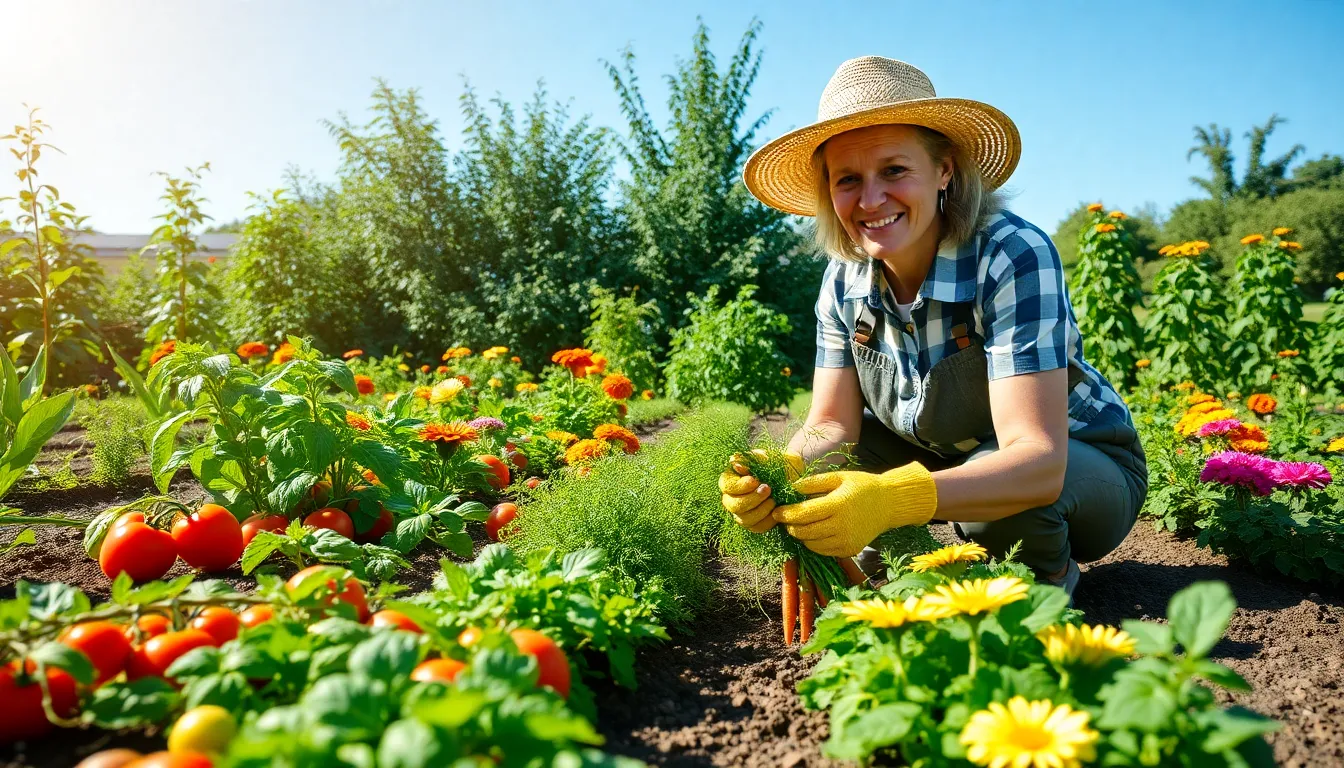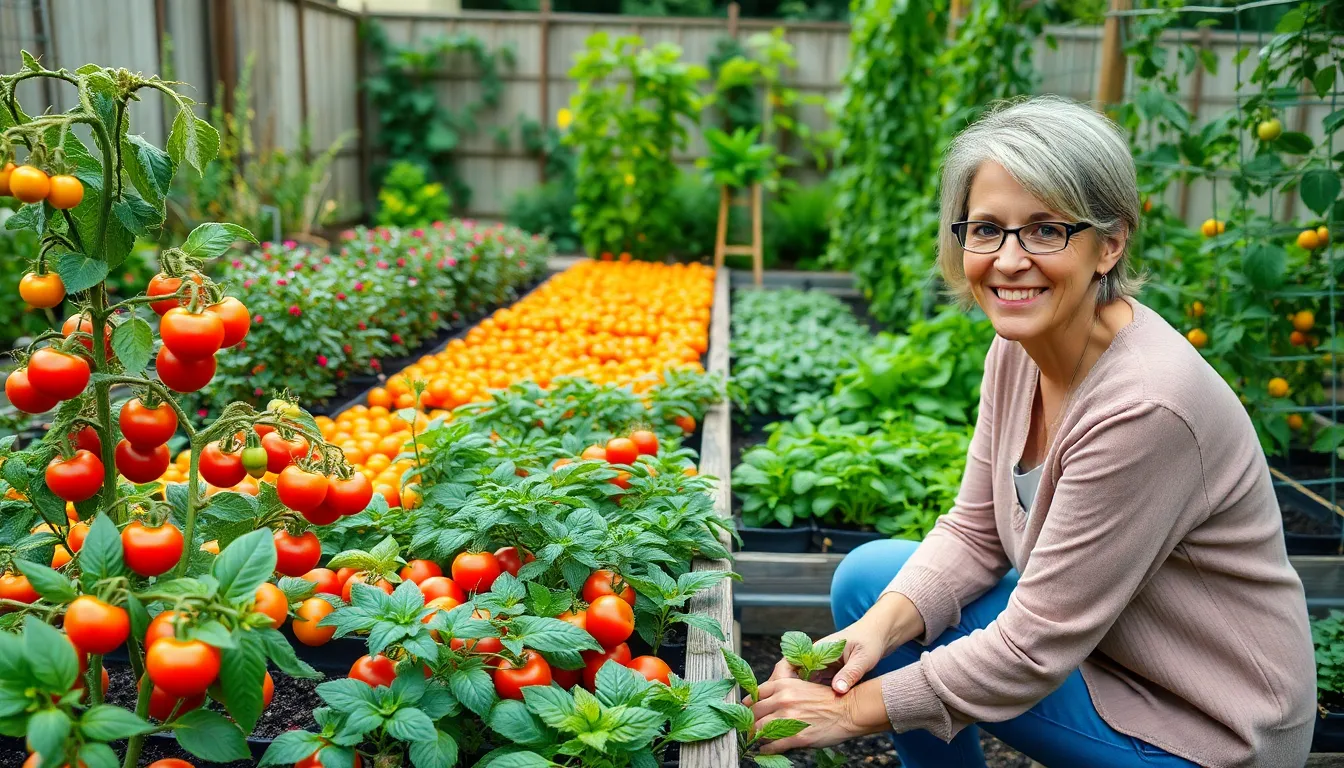Imagine stepping into your backyard and being greeted by a vibrant patch of greens, bursting with life and flavor. Vegetable gardens aren’t just about growing food; they’re a delightful way to unleash creativity and reconnect with nature. Whether you’re a seasoned gardener or just starting out, there’s a world of vegetable garden ideas waiting to transform your outdoor space into a culinary wonderland.
Table of Contents
ToggleCreative Vegetable Garden Ideas
Exploring innovative vegetable gardening concepts can significantly enhance any outdoor space. Here are two popular methods that maximize productivity and creativity.
Vertical Gardening Techniques
Vertical gardening techniques utilize limited space effectively, allowing gardeners to grow various vegetables. Wall planters, trellises, and vertical shelves create eye-catching displays. Crops like cucumbers, tomatoes, and pole beans thrive in these setups. Implementing hanging pots with herbs also adds functionality and elegance. An added benefit includes easy access for maintenance, promoting a more enjoyable gardening experience.
Container Gardening Options
Container gardening options provide flexibility and accessibility for urban dwellers or those with small yards. Selecting pots of different sizes accommodates various vegetables, from leafy greens to root crops. Drainage holes are crucial to prevent overwatering; using self-watering containers aids in managing moisture levels. Incorporating colorful containers enhances aesthetics while growing food. Positioning containers strategically allows for optimal sunlight exposure, ensuring healthy plant growth.
Planning Your Vegetable Garden Layout

Planning a vegetable garden layout involves strategic placement to maximize growth and yield. Thoughtful arrangements can optimize sun exposure, improve air circulation, and simplify maintenance.
Companion Planting Strategies
Companion planting promotes beneficial relationships between plants. Tomatoes thrive alongside basil, which enhances their flavor while repelling pests. Carrots and onions share space effectively, reducing damage from pests like carrot flies. Incorporating marigolds deters harmful insects and attracts beneficial pollinators. These simple pairings can foster a healthier garden ecosystem.
Seasonal Planting Considerations
Seasonal planting greatly influences vegetable garden success. Spring serves as the perfect time for cool-weather crops like lettuce, peas, and radishes. Summer heat encourages warm-season crops such as tomatoes, peppers, and squash. Fall provides an opportunity to plant hardy vegetables like kale and brussels sprouts, which can withstand cooler temperatures. Adapting planting schedules according to seasons ensures optimal growth and bountiful harvests.
DIY Vegetable Garden Solutions
DIY vegetable garden solutions offer creative options for enhancing gardening experiences and productivity. These methods cater to various space constraints and personal preferences.
Raised Bed Construction
Constructing raised beds provides an effective way to manage soil quality and drainage while increasing yield. Start by selecting durable materials like untreated wood or composite materials to build the frame. Typically, a height of 12 to 24 inches works well for accessibility and encourages healthy root development. Fill the beds with a mix of topsoil, compost, and organic matter to create a nutrient-rich environment for plants. Use a grid or square foot gardening approach to maximize space efficiency, optimizing every inch for planting. This structured design also simplifies maintenance and weeding, making raised beds a popular choice for gardeners looking to enhance their productivity.
Pallet Garden Ideas
Using pallets creates innovative garden solutions that utilize limited space effectively. Begin by selecting clean, untreated pallets to avoid chemical exposure to plants. Transform the pallets into vertical gardens by standing them upright and filling each compartment with soil. This method supports a variety of plants, such as herbs and smaller vegetables. Alternatively, lay the pallets flat to create a compact garden area, allowing for easy planting and maintenance. Consider incorporating wheels or legs for mobility, especially in smaller spaces, ensuring that plants receive optimal sunlight while being easy to access for care. Pallet gardens not only maximize space but also add a unique aesthetic element to any outdoor setting.
Common Mistakes to Avoid
Starting a vegetable garden comes with challenges. Many gardeners underestimate the importance of soil quality, leading to poor plant growth. Choosing the wrong location can hinder sun exposure and airflow, negatively impacting crop development.
Ignoring companion planting concepts presents another frequent error. Certain plants thrive when planted together; for instance, tomatoes benefit from proximity to basil. All plants should be strategically paired to maximize yield and minimize pest issues.
Overwatering is a common mistake as well. Ensuring proper drainage in containers or raised beds prevents root rot and keeps plants healthy. It’s crucial to monitor moisture levels regularly, especially during dry periods.
Planting at incorrect times can also stunt growth. Cool-weather crops, such as spinach and lettuce, do best in early spring. Warm-season vegetables like peppers and cucumbers thrive after the last frost.
Neglecting pest management can lead to disaster. Regularly inspecting plants for signs of infestation helps detect problems early. Utilizing organic methods can also protect beneficial insects that contribute to the garden ecosystem.
Lastly, failing to rotate crops each year risks soil depletion. Different plants require different nutrients. Rotating crops helps maintain soil health and improves the overall harvest.
By avoiding these common mistakes, gardeners can enhance productivity and enjoyment in their vegetable gardening endeavors.
Embracing vegetable gardening opens up a world of creativity and sustainability. With innovative ideas like vertical and container gardening, anyone can cultivate a flourishing garden regardless of space limitations. Thoughtful planning and companion planting not only enhance yields but also nurture a vibrant ecosystem.
DIY solutions such as raised beds and pallet gardens provide practical and visually appealing options for gardeners of all skill levels. By avoiding common pitfalls and focusing on soil health and proper timing, vegetable gardeners can enjoy a bountiful harvest while reconnecting with nature. The journey of growing vegetables is not just about food; it’s about cultivating joy and fulfillment in every season.




